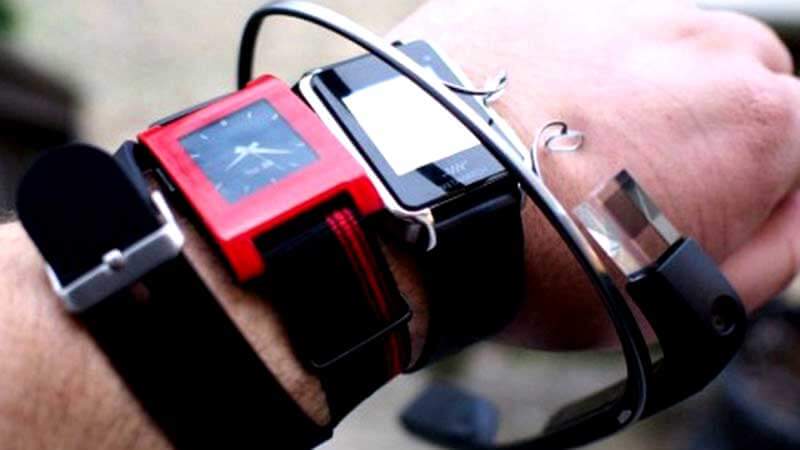- Wearables maken een toekomst van handsfree winkelen mogelijk
- Virtual en augmented reality: winkelen naar nieuwe niveaus van gemak
- Hyperconnectiviteit stroomlijnt retail en verrijkt consumentenbeleving
- Staan er binnenkort robots in onze supermarkt?
- In-store winkelen krijgt een hightech upgrade
In de winkels van de toekomst zijn geen wachtrijen en zitten er geen mensen achter de kassa. Sterker nog, er zijn geen kassa’s. We hoeven onze eigen boodschappen niet meer in te pakken en we betalen met onze wearables. Afhankelijk van het type winkel, gaat winkelen in de toekomst óf over de beleving óf over extreem gemak.
Het lijkt eigenlijk nog maar zo kort geleden dat we kennismaakten met het Internet en de smartphone. Ontwrichtende technologieën die de manier waarop we leven en werken drastisch hebben veranderd. Deze technologische ontwikkelingen hebben de weg vrijgemaakt voor wat we de komende jaren in de detailhandel tegenkomen. Denk daarbij aan wearables, virtual en augmented reality, hyperconnectiviteit en robotica. Al deze technologieën spelen in de toekomst van retail een belangrijke rol.
Wearables maken een toekomst van handsfree winkelen mogelijk
Het aantal wearables op de markt neemt razendsnel toe en bereikt in 2020 naar verwacht maar liefst 650 miljoen. Dit betekent dat steeds meer mensen in de toekomst smartwatches, activiteitstrackers en andere wearables dragen. Op deze apparaten wordt belangrijke informatie als identiteitsgegevens en bankdetails, maar ook informatie over het koopgedrag van de drager opgeslagen. In de toekomst zien we steeds meer mogelijkheden voor contactloos betalen, mobiel betalen en betalen met biometrische technologieën als gezichtsherkenning. Hierdoor hebben we binnenkort geen creditcards, pincodes en handtekeningen meer nodig. Met zo’n wearable loopt een klant gewoon een winkel binnen, pakt hij wat hij graag wil hebben en loopt hij de winkel vervolgens weer uit waarna het te betalen bedrag automatisch van zijn rekening wordt afgeschreven. Stel je een toekomst van hands-free winkelen voor, waarin de hele winkelervaring – van rondneuzen tot kopen – mogelijk wordt gemaakt door een wearable. Die toekomst staat al voor de deur.

Virtual en augmented reality: winkelen naar nieuwe niveaus van gemak
Stel, je wilt met vrienden op vakantie naar Spanje. Je hebt besloten om te gaan kamperen, maar nu moet je gaan shoppen voor een tent. Uiteindelijk vinden jullie er eentje en vervolgens kruipen jij en je vriend erin om te zien of de tent groot genoeg is. Iets ongewoons gemerkt aan dit scenario? Geen van jullie beiden is namelijk in de buurt van een sport- of kampeerzaak. Sterker nog, jij zit in Amsterdam en je vriend zit in Londen. Maar dankzij virtual reality kun je elkaar waar dan ook ter wereld ontmoeten, op elk moment van de dag, zonder ook maar een voet buiten de deur te zetten. Virtual reality dompelt de gebruiker – die een VR-headset op heeft – onder in een gesimuleerde wereld.
Augmented reality plaatst een digitale laag met informatie over de werkelijkheid – die je ziet door je smartphone of tablet of ook door een headset. Zowel VR als AR bieden retailers en online merchants de mogelijkheid om de manier waarop hun klanten winkelen te revolutioneren. Of ze nu een overhemd willen aanpassen of zien hoe die designer tafel in de huiskamer staat, virtual en augmented reality zorgen voor een ongekende klantervaring en efficiënte klantenservice. Ook maken de technologie korte metten met vele pijnpunten. Met online VR-toepassingen heeft de klant vanuit zijn eigen luie stoel direct contact met de winkel. Een e-commerce retailer kan bijvoorbeeld een 3D-versie van een echte fysieke winkel ontwikkelen waarin de klant een jurk kan aanpassen. Met in-store VR en AR-toepassingen kan de klant tijdens het winkelen met de techniek interacteren, bijvoorbeeld in de kleedkamer van een boetiek. Een klant kan bijvoorbeeld ook een virtuele make-upspiegel gebruiken om allerlei kleuren lippenstift te proberen, in plaats van op een medewerkster van de cosmetica-afdeling te hoeven wachten.
Met virtual en augmented reality kan de retailer de klantervaring volledig personaliseren. De sector is hot en VR en AR investeringen in de detailhandel bedragen in 2020 naar schatting maar liefst $30 miljard.
Hyperconnectiviteit stroomlijnt retail en verrijkt consumentenbeleving
We leven natuurlijk al een tijd in een superconnected wereld, maar over tien jaar, wanneer het Internet of Things deel is van de dagelijkse structuur van het leven, zijn we zelfs hyperconnected. Dan communiceert alles met alles. Niet alleen mensen met mensen. Maar ook mensen met apparaten – en apparaten met andere apparaten.
Dit betekent in de retail sector dat indoor en outdoor digitale reclameborden binnen en buiten, vitrines, kledingrekken, supermarktschappen, sensoren, smart tags, wearables, smartphones en andere apparaten volgen, monitoren, analyseren, rapporteren, suggereren en adviseren. De winkelvoorraden worden dan automatisch bijgevuld en klanten krijgen automatisch updates over nieuwe collecties en speciale aanbiedingen als ze in de buurt zijn van een winkel waar ze eerder zijn geweest of interesse in hebben getoond. Reclamemateriaal en andere content wordt naar verbonden digitale of virtuele displays gestreamd. En wat de klant te zien krijgt hangt vanzelfsprekend af van zijn behoefte of interesse, maar ook van hoe laat het is, welke dag, maand of seizoen het is en ook van de locatie en de weersomstandigheden. Bij ons thuis betekent hyperconnectiviteit dat onze huishoudelijke apparaten met de supermarkt communiceren. Als de slimme koelkast ‘merkt’ dat de kaas bijna op is, bestelt het apparaat dat zelf. De boodschappen worden natuurlijk ook automatisch thuisbezorgd en zeer waarschijnlijk door een drone. Dankzij hyperconnectiviteit kunnen producten, apparaten en toestellen multidimensionale lagen vormen die activiteiten in winkels, kantoren en woningen stroomlijnen en klantervaringen verrijken.
Staan er binnenkort robots in onze supermarkt?
Als het aan Amazon ligt, zijn sciencefiction-achtige supermarkten binnenkort werkelijkheid. Het bedrijf heeft onlangs haar eerste ‘Amazon Go’ supermarkt in Seattle geopend waar klanten nooit in de rij hoeven te staan. Ze maken gebruik van de Amazon Go app om de winkel binnen te gaan, vervolgens pakken ze de producten die ze nodig hebben en verlaten ze de winkel weer. Dit automatische winkelen wordt mogelijk gemaakt door een systeem van sensoren, computer vision en diep leren. Hiermee wordt door het geavanceerde virtuele winkelwagentjessysteem bijgehouden wat er uit het winkelschap gepakt wordt en/of weer teruggezet wordt. Naast de bekende merken en basisvoedingsmiddelen zoals melk en brood, heeft de supermarkt ook verse ontbijtjes, lunches, snacks en maaltijdpakketten, handgemaakte bonbons, kaas en andere speciale producten. De boodschappen worden automatisch van het Amazon-account van de shopper afgeschreven. De Amazone Go winkel is momenteel alleen toegankelijk voor Amazonpersoneel, maar de online retailgigant is van plan om de winkel dit jaar ook voor het publiek te openen.
Volgens een rapport van de Wall Street Journal uit december 2016, evenals een recent artikel in de New York Post heeft Amazon nog veel grotere plannen. Er wordt gezegd dat de online retailgigant van plan is om maar liefst 2.000 geautomatiseerde supermarkten met twee verdiepingen te openen waarin robots het meeste werk verrichten. Op de begane grond vindt men duizenden producten als vlees, groenten en zuivelproducten en op de bovenste verdiepingen pakken robots de boodschappen voor de klanten in. In deze supermarkten zullen maar drie tot tien mensen werken. Deze worden ingezet bij de drivethrough om boodschappen aan klanten te geven. Ook kunnen ze ingezet worden voor het bijvullen van de schappen en om de robots op de tweede verdieping te helpen met het inpakken van de boodschappen. In deze supermarkten staan geen rijen wachtende mensen en er zijn geen caissières. Klanten maken gebruik van een app die detecteert welke boodschappen de klant meeneemt.
Bij de ingang staan ‘begroeters’ met hightech sensoren om winkeldiefstal en andere problemen te voorkomen of op te lossen. Zoals bekend maakt Amazon al geruime tijd gebruik van robots. De magazijnen van het bedrijf staan er vol mee en hun plannen om in de toekomst bezorgdrones in te zetten zijn alom bekend. Ook heeft het bedrijf octrooi aangevraagd op een onbemand luchtschip dat als zwevend magazijn moet dienen.
Jeff Bezos, CEO van Amazon, heeft de speculaties rondom de Amazon robot-supermarkten overigens ontkend. Hij zei: “wie deze verhalen de wereld in heeft gebracht heeft zeker de verkeerde medicijnen ingenomen.” Maar, waar rook is, is meestal ook vuur, dus we houden de ontwikkelingen zeker in de gaten.
In-store winkelen krijgt een hightech upgrade
Retail ondergaat een revolutionaire transformatie. Ontwikkelingen als robotica, wearables, persoonlijke herkenningstechnologie, kunstmatige intelligentie en andere slimme technologieën maken het winkelen steeds persoonlijker en efficiënter. Klanten verwachten steeds meer dat diensten en producten precies aan hun specifieke behoeften voldoen, en let’s face it: de klant is de baas. Als de retailer wil overleven en met kop en schouders boven de anderen wil uitsteken is het van cruciaal belang om de nieuwe technologische ontwikkelingen te omarmen, ook al is de sector van oudsher wat terughoudend met het omarmen van veranderingen.
Een paar voorbeelden van retailers die de nieuwste slimme technologie wel omarmen zijn de Amerikaanse warenhuizen Nordstrom en Macy’s, die onder andere slimme paskamers hebben geïnstalleerd. Door gebruik te maken van camera’s vanuit verschillende hoeken maakt men een 3D-model van een klant. Hierop kan de klant vervolgens kleding passen. De beelden worden geüpload naar een smartphone app zodat de klant allerlei verschillende outfits kan proberen, zowel vanuit de eigen luie stoel als vanuit de fysieke winkel, zonder zelf uit de kleren te hoeven.
Nordstrom heeft ook social media-elementen geïntegreerd in hun fysieke winkels om klanten aan te moedigen hun favoriete Nordstrom aankopen op Pinterest en andere platforms te delen. Met behulp van leuke interactieve displays laat Nordstrom vervolgens de meest populaire items in hun winkels zien. Voor hun verkoopassistenten creëerde het bedrijf ook een app waarmee zij in real time kunnen zien welke van hun producten het meest populair zijn op Pinterest, waarop zij hun winkelvoorraad vervolgens kunnen afstemmen.
In-store shopping gaat nergens heen; het krijgt gewoon een aantal broodnodige upgrades. Technologie overbrugt de kloof tussen online en in-store, waardoor winkelen eigenlijk steeds efficiënter en leuker wordt.
Share via:


